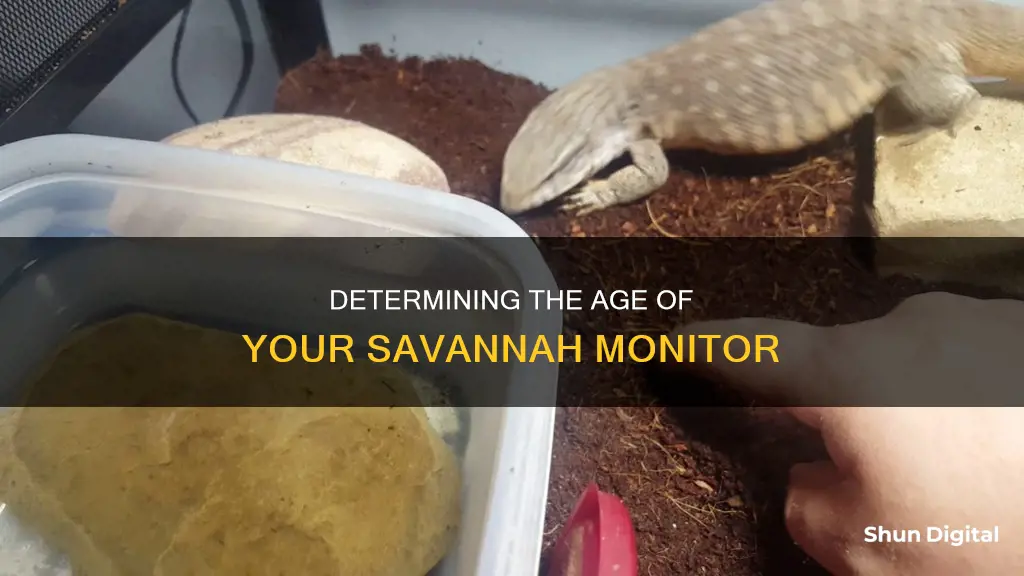
Savannah monitors are medium-sized lizards that can make good pets for experienced owners. They are native to the savannahs and grasslands of sub-Saharan Africa and are known for their docile temperament. While they can be great pets, they require a lot of care and attention and are not recommended for beginners. One of the key aspects of their care is providing a suitable enclosure that meets their size and environmental needs. Their diet also requires careful management to prevent obesity and related health issues. So, how do you tell the age of a Savannah monitor?
| Characteristics | Values |
|---|---|
| Scientific Name | Varanus exanthematicus |
| Adult Size | 3 to 4 feet long |
| Life Expectancy | 10 years on average; some may live up to 15 years |
| Weight | 11 to 13 lbs |
| Body Colour | Light yellow to grey |
| Markings | Light yellow marks on the head and circular dark-edged yellow spots on the back |
| Ventral Colour | Yellowish-grey to brown |
| Tail Colour | Alternating rings of yellowish and brown |
| Tongue Colour | Blue |
| Habitat | Savannah, open forests, woodlands, desert-type areas |
| Diet | Toads, snakes, small mammals, birds, lizards, eggs, insects, rodents |
| Sexual Maturity | 1.5-2 years of age |
What You'll Learn

Savannah monitor growth rates
Savannah monitors grow rapidly in the first two months of their lives and can reach sexual maturity at 1.5–2 years old. In the wild, hatchlings are around 5 inches (13 cm) in SVL (snout-vent length) and weigh 0.25 oz (6–7 gm). By the time they are adults, they average 13 inches (33 cm) SVL, 25 inches (64 cm) STL (snout-to-tail tip length), and weigh about 1.6 pounds (0.753 kg).
In captivity, Savannah monitors tend to be larger than their wild counterparts due to the regular availability of food. Captive-bred hatchlings may also be larger than wild hatchlings because of the controlled level of humidity provided in artificial incubators.
The greatest period of growth for a Savannah monitor is within the first two to three years, and this is when the greatest amount of food is required. Hatchlings (up to one foot in length) should be fed one to four small mice or fuzzies every two to three days. Juvenile/subadults (up to three feet in length) should be fed one to four mice twice a week. Adults (three or more feet in length) can be fed twice a week, adjusted based on weight gain and the amount of exercise.
The growth rate of a Savannah monitor also depends on the size of its enclosure. Monitors kept in subpar fish tanks will show much slower growth than those in larger, custom-made enclosures from the beginning.
Monitoring Linux Memory Usage: A Comprehensive Guide
You may want to see also

Housing requirements
Savannah monitors require large enclosures with high temperatures. A hatchling or juvenile will live comfortably in a 20-30 gallon tank or 55-gallon aquarium for about six months, but they grow quickly and most owners have their adult setup ready when they bring home a baby. The enclosure for an adult should be at least 8 feet long by 4 feet wide and 3 feet high, with a minimum size of 5 feet x 4 feet x 4 feet. The height of the enclosure should prevent the monitor from escaping and provide space for a branch or other decoration. The enclosure must be entirely enclosed and have a secure lock as these lizards are strong and known for being escape artists.
The enclosure should be custom-built and made of plexiglass or plastic. The top should have a screen to allow for airflow while being secured to prevent escapes. The substrate should be something that can be easily cleaned, such as newspaper, as monitors are very messy and defecate frequently. Avoid using sand or gravel as this can cause bowel obstruction, especially in juveniles. Also, avoid reptile carpet as it can entangle and tear their large claws.
The water bowl should be large enough for the monitor to soak in and should be heavy and easy to disinfect. The ambient temperature within the enclosure should range from 80°F on the cool side to 90°F on the warmer side, with a basking spot of around 100°F. Nighttime temperatures can be maintained at 75°F using heating pads or ceramic heat emitters. UVB lighting is necessary and should be on for 10-12 hours a day.
Savannah monitors are natural diggers, so a substrate that allows for this behaviour is recommended, such as mulch-type bedding or organic potting soil. The substrate should be deep enough for the monitor to burrow, with a depth of one to two feet. The enclosure should also include some logs, branches, rocks, and cork bark slabs that can be easily cleaned or removed for cleaning. Live plants should be avoided as they will die in the extreme heat.
Asus Portable Monitors: Compatible Partners for MacBook Pro 13?
You may want to see also

Diet and weight
The Savannah monitor is a carnivorous lizard and an opportunistic eater. In the wild, they primarily eat invertebrates like beetles, centipedes, millipedes, spiders, and scorpions. They also eat small mammals, birds, amphibians, and reptiles when available.
In captivity, their diet should consist of insects (crickets, roaches, mealworms), occasional rodents, and varied invertebrates. Lean meats like chicken or beef can be given in moderation but should not replace a varied diet.
Juvenile Diet
Young and sub-adult Savannah monitors should be fed daily, with a diet consisting of insects and other invertebrates. Calcium supplements are also important for juveniles.
Adult Diet
Adult Savannah monitors can be fed every 2-3 days. Their diet can include insects, rodents, and invertebrates. It is important to monitor their weight and adjust the feeding accordingly, as they are prone to obesity.
Signs of a Healthy Weight
A healthy Savannah monitor should have a robust but not bloated appearance. There should be a fold of skin across their body down by their belly, and the muscles at the base of the tail should be visible. If the spine is visible, the lizard is likely underweight or not getting enough exercise.
Overweight and Underweight
If a Savannah monitor is overweight, it is recommended to feed them less often, offer less fatty food, and provide more opportunities for exercise. An obese monitor will not live a long life and is at risk of fatty liver disease.
If a monitor is underweight, it may be necessary to increase the amount of food or feed more calorie-dense options.
Common Dietary Deficiencies
Signs of dietary deficiencies in Savannah monitors include lethargy, soft or deformed bones, difficulty walking, or a swollen jaw, which may indicate metabolic bone disease.
Water Intake
Fresh water should always be available for Savannah monitors, as they drink when needed and use water for soaking.
Tips for Owners
- It is important to monitor the weight of your Savannah monitor regularly to prevent excess weight gain.
- A separate tank for feeding can help keep the main enclosure clean and reduce the risk of impaction from ingesting substrate with prey.
- Avoid hand-feeding, as this may cause the lizard to associate your hand with food and lead to accidental bites.
- It is generally safer to feed pre-killed prey to reduce the risk of injury to the monitor.
- Gut-loading insects before feeding them to the monitor ensures that they are nutrient-rich.
- Avoid avocado, chocolate, caffeine, onions, and grapes, as these foods are toxic to Savannah monitors.
- Rotate between different types of food and introduce new safe foods occasionally to provide a varied and nutritious diet.
Monitoring Water Usage in Hillsborough, California: A Guide
You may want to see also

Health and parasites
Savannah monitors are susceptible to various health issues, including parasitic infections, respiratory infections, and metabolic bone disease.
Internal parasites can cause loss of appetite, bloating, vomiting, sudden weight loss, sluggish movements, and constipation. External parasites, such as tics and mites, can also attach to the skin and suck blood, leading to a lack of appetite and a weakened immune system. To treat parasites, consult a veterinarian, who will typically prescribe oral or injected medication.
To prevent and treat parasitic infections, proper hygiene and sanitation are crucial. Clean the water dish daily and replace the water to avoid waste buildup. Regularly disinfect the enclosure, especially if the lizard defecates in its water bowl. Use a large water dish that is difficult for the lizard to tip over.
Symptoms of respiratory infections include listlessness, weight loss, swollen or bloated body, gasping, open-mouth breathing, wheezing, and mucus in the mouth. If you notice these signs, consult a veterinarian experienced in treating reptiles and make necessary environmental corrections, such as adjusting temperature and humidity levels.
Metabolic bone disease is another common health issue in Savannah monitors, resulting from improper diet or environment. It can be prevented by providing a nutritious diet with adequate calcium and vitamin D, and exposure to UVB rays.
To ensure the health of your Savannah monitor, provide a suitable diet, maintain optimal hygiene, and consult a veterinarian experienced in treating reptiles if any health issues arise.
Unplugging an Asus Monitor: A Step-by-Step Guide
You may want to see also

Handling and taming
Initial Acclimatisation
Give your Savannah monitor time to get used to its new surroundings. It may take a few weeks for it to settle in and start feeding well. Wild monitors will likely be defensive and may hiss, crouch down, or slap you with their tails. Allow your monitor to hide and acclimatise on its own, and it will be healthier in the long run.
Handling
Savannah monitors can be tamed and trusted with time and patience. They are intelligent and may even begin to recognise you and seek out your attention and affection. However, they can bite, scratch, and whip their heavy tails, so be cautious.
Daily contact and handling are required for taming and training. Avoid sudden movements, but move with confidence. When holding your monitor, provide support under its chest and hind limbs. Being terrestrial, they are most comfortable when they feel a surface under their feet.
There will be times when your monitor does not want to be handled, so look out for signs of aggression, such as enlarging its throat or standing on its hind legs. If you proceed when your monitor is displaying these signs, you will likely be bitten.
Bonding
Your monitor may display signs of affection towards you once a bond is formed. You can encourage bonding by providing extra enrichment through activities such as:
- Modifying Wiffle balls to hold freeze-dried or canned insects for them to play with
- Sprinkling different spices and new substrates for them to smell
- Hiding pieces of food under pieces of terrarium furniture
- Providing weekly outdoor swimming sessions in a large kiddie pool for extra exercise and UV exposure
Health and Safety
Keep your monitor's nails trimmed to reduce the frequency and severity of accidental and intentional injuries. Nail trimming requires experience in handling reptiles and should be done by two people.
Be aware that your monitor may try to escape, so ensure its enclosure is entirely enclosed and has a secure lock. Keep the door to the room closed at all times and consider keeping it locked if there is a risk of curious children or careless adults entering the room.
Monitor Sizes: Common Display Dimensions for Your Setup
You may want to see also







